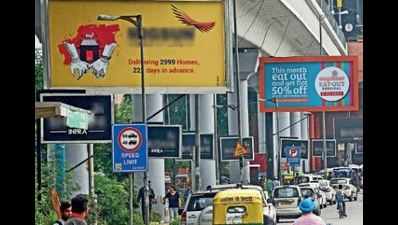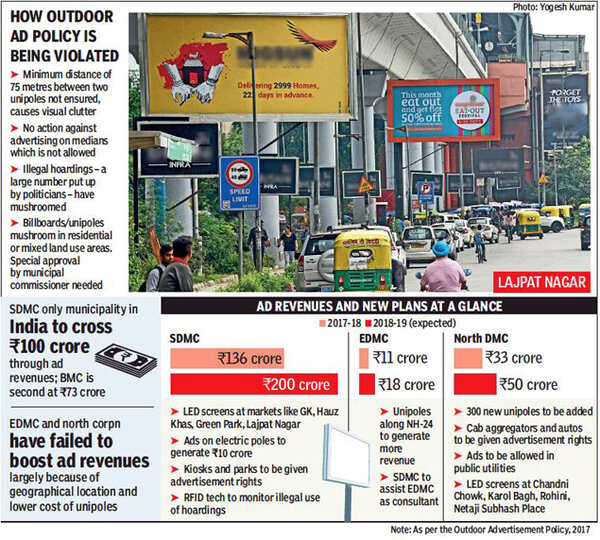- News
- City News
- delhi News
- Visual clutter a poor advertisement for Delhi
Trending
This story is from September 24, 2018
Visual clutter a poor advertisement for Delhi

NEW DELHI: Every 10 metres on the stretch of Outer Ring Road near Lajpat Nagar market, you can see advertisements of a private company. No probable space, including unipoles and toilet complexes, has been spared. Maheshwari Devi, who frequents the market, is aghast. “You don’t see any empty space along the road and it all feels so congested,” she said. “There is a certain orderliness to hoardings compared with earlier times, but they have certainly overdone it.”
This visually loathsome vista of advertising boards across south Delhi brings a sparkle to the eyes of the South Delhi Municipal Corporation officials, who are eyeing an income of over Rs 200 crore from ads this year.They willingly turn a blind eye to the clutter, as do the two other municipal corporations, despite the Supreme Court instructing, when clearing the outdoor advertising policy formulated with the help of the court-mandated Environment Pollution Control Authority in August 2017, that while managing hoardings, effort should be made “to avoid visual clutter and ensure safety of the people as well as aesthetics”.

Under the policy, the capital is divided into clusters, each eligible to hold 60-70 unipoles, or advertising structures comprising single steel columns. Certain norms are to be followed, like a 75-metre distance between two unipoles, keeping pavements free of hoardings and giving the array of hoardings a uniformity.
There, however, is a grey area in the policy that gives the corporation officials the ground for permitting the clutter. The advertisement policy may mandate a separation of 75m between two unipoles, but only 5m is necessary to separate two mupis, which are smaller boards used for advertising, and no specific direction has been issued for flagpoles, which occupy a space similar to a mupi.
So, when asked about the clutter on the roads, an SDMC official was quick to explain, “There is no limit on the number of mupis that can be installed on any stretch. We have clubbed it with street furniture, and the agency using mupis is also expected to maintain the dustbins, police booths and toilets.” He added that there is no restriction to the placement of flagpoles so long as “pedestrian movement is not restricted”.
Despite the obvious advantage taken of the policy’s ambiguity, Prem Shankar Jha, deputy commissioner of the advertisement department in SDMC, maintained curbing the illegal use of unipoles was beneficial to the civic body. “We issued 1,500 legal notices and filed 950 complaints against the brand, not the local representative or PR firm. If the orders of top companies get cancelled, the market will automatically be disciplined.” But SDMC may not be keen to be overaggressive. It expects a big increase this year over the Rs 136 crore it earned from ads last year and the Rs 43 crore in 2015-16.
Meanwhile, B M Bakshi, president of the New Friends Colony RWA, complained, “The arterial road in our area is claustrophobic with ads. Forget about the 75-metre rule, every few steps you run into banners.” Civic officials claimed that monitoring was not possible due to depleted field staff. But as insiders revealed, the fact that many officials of SDMC’s advertisement department have been replaced for “foul play” indicates that there is money to be made for permitting illegal publicity.
This visually loathsome vista of advertising boards across south Delhi brings a sparkle to the eyes of the South Delhi Municipal Corporation officials, who are eyeing an income of over Rs 200 crore from ads this year.They willingly turn a blind eye to the clutter, as do the two other municipal corporations, despite the Supreme Court instructing, when clearing the outdoor advertising policy formulated with the help of the court-mandated Environment Pollution Control Authority in August 2017, that while managing hoardings, effort should be made “to avoid visual clutter and ensure safety of the people as well as aesthetics”.

Under the policy, the capital is divided into clusters, each eligible to hold 60-70 unipoles, or advertising structures comprising single steel columns. Certain norms are to be followed, like a 75-metre distance between two unipoles, keeping pavements free of hoardings and giving the array of hoardings a uniformity.
The norms are flouted openly by firms that have won the rights to the clusters, and the civic bodies seem happy to ignore these. TOI noted the 75-metre rule being violated by the cluster operator on flyovers and in commercial hubs in south Delhi and the density of unipoles there was much higher than prescribed. In areas like Lajpat Nagar and along Vikas Marg, Akshardham Road and Mathura Road, unipoles were planted on pavements in flagrant violation of the norm. Each unipole brings in Rs 3-4 lakh per month.
There, however, is a grey area in the policy that gives the corporation officials the ground for permitting the clutter. The advertisement policy may mandate a separation of 75m between two unipoles, but only 5m is necessary to separate two mupis, which are smaller boards used for advertising, and no specific direction has been issued for flagpoles, which occupy a space similar to a mupi.
So, when asked about the clutter on the roads, an SDMC official was quick to explain, “There is no limit on the number of mupis that can be installed on any stretch. We have clubbed it with street furniture, and the agency using mupis is also expected to maintain the dustbins, police booths and toilets.” He added that there is no restriction to the placement of flagpoles so long as “pedestrian movement is not restricted”.
Despite the obvious advantage taken of the policy’s ambiguity, Prem Shankar Jha, deputy commissioner of the advertisement department in SDMC, maintained curbing the illegal use of unipoles was beneficial to the civic body. “We issued 1,500 legal notices and filed 950 complaints against the brand, not the local representative or PR firm. If the orders of top companies get cancelled, the market will automatically be disciplined.” But SDMC may not be keen to be overaggressive. It expects a big increase this year over the Rs 136 crore it earned from ads last year and the Rs 43 crore in 2015-16.
Meanwhile, B M Bakshi, president of the New Friends Colony RWA, complained, “The arterial road in our area is claustrophobic with ads. Forget about the 75-metre rule, every few steps you run into banners.” Civic officials claimed that monitoring was not possible due to depleted field staff. But as insiders revealed, the fact that many officials of SDMC’s advertisement department have been replaced for “foul play” indicates that there is money to be made for permitting illegal publicity.
End of Article
FOLLOW US ON SOCIAL MEDIA










